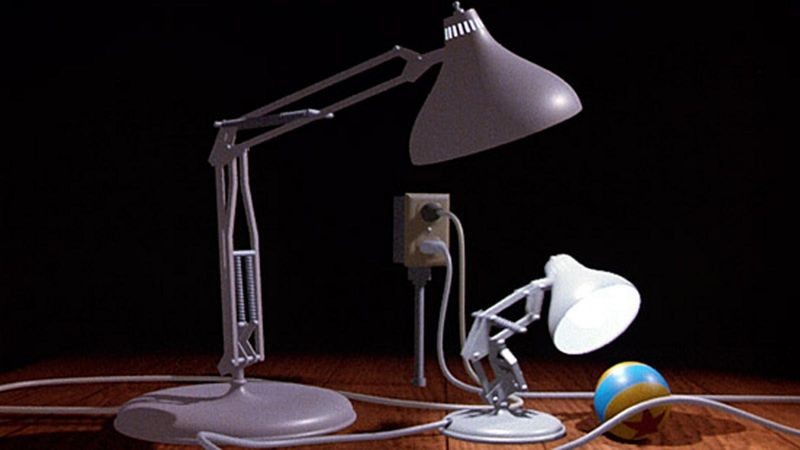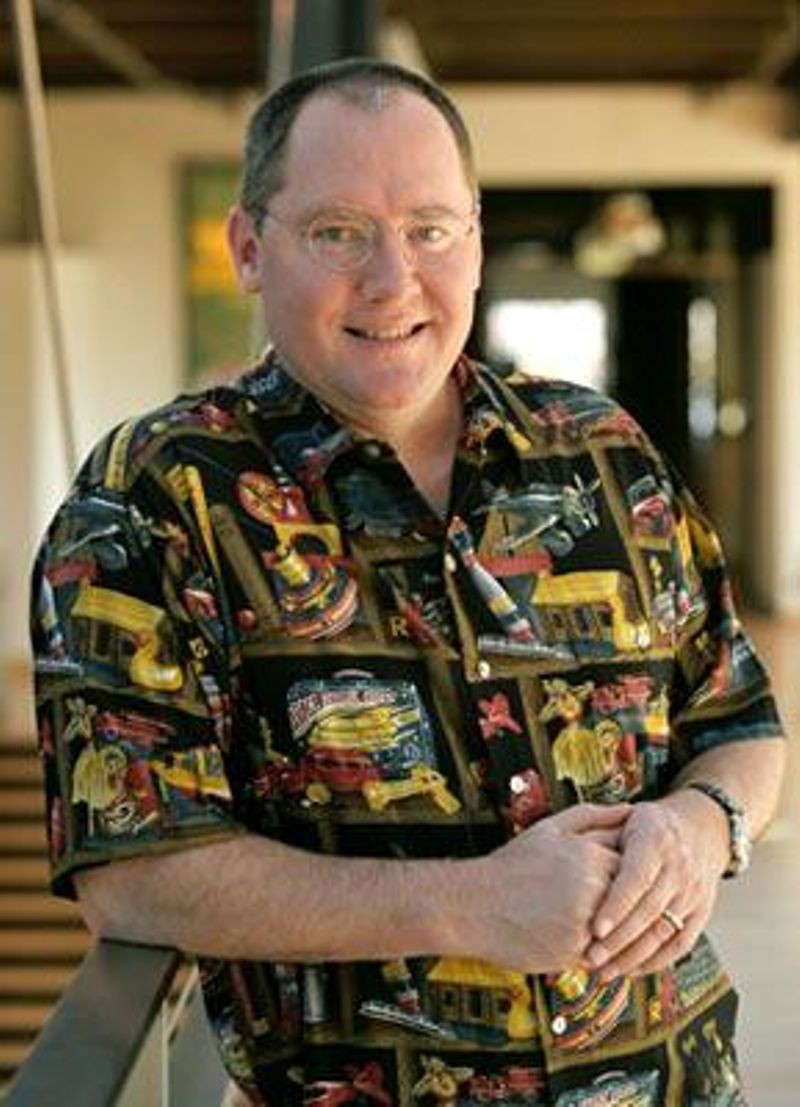

A still from Pixar’s Luxo Jr.
Perhaps the single most iconic character in the history of computer graphics isn’t a representation of a living thing. It’s a desk lamp. For more than twenty-five years, it has served as the symbol for one of the pioneering companies in the field of computer animation, Pixar, and it all started with the fascination held for a lamp on John Lasseter’s desk.
The graphics group at Lucasfilm was only one-third of the total computer division. They were largely associated with Industrial Light & Magic on creating computer-generated effects for films. In 1984, the graphics group created a short film called The Adventures of Andre & Wall-E which debuted at the annual SIGGRAPH conference. The short was the biggest hit of the conference and would go on to show at film festivals around the world. In 1985, the team showed off the footage of The Stained Glass Knight from Spielberg’s Young Sherlock Holmes. This sequence, considered a turning point for the graphics community as it was a computer-generated character in a mainstream film, was the last major project undertaken by the graphics group before it was spun off as an independent company. Renamed Pixar, it was not initially a film production company, but a hardware and software company. At the beginning of the company, a few projects were begun to create short, computer-generated films. These were not seen as money-making projects by management, but more as demonstration pieces for the products Pixar was releasing, including the RenderMan graphics software package and Pixar Image Computer. Usually, these were meant to be short pieces that could be shown at events such as SIGGRAPH to drum up interest in their products.
John Lasseter had been fascinated by animation since he was a high school freshmen, setting his sights on working in animation after seeing Disney’s The Sword and the Stone. Lasseter attended CalArts, where he created his short film The Lady and the Lamp in 1979. It featured a broken-bulbed lamp taking part in wacky hijinks. The anthropomorphization of everyday, inanimate objects had been a staple of animation dating back to the earliest days of film. Walt Disney particularly understood the value of giving regular objects human attributes, such as the animated brooms in The Sorcerer’s Apprentice segment from Fantasia. Lasseter worked with the Luxo lamp form, modeling it and finding ways to make it appear to have emotional movement. A visit from a co-worker’s baby led Lasseter to experiment with the idea of a baby Luxo lamp. He redistributed the attributes of the lamp, shrinking many parts and changing the proportions. All except the lightbulb, which were purchased at the store and not grown, according to Lasseter’s reasoning.
He conceived of a short character study where the parent lamp and the child lamp interacted. The justification for the project to Pixar’s heads Ed Catmull and Alvy Ray Smith was to demonstrate ‘self-shadowing’, or how the intensities of the light from the lamps interacted with their environment and off of the lamps themselves. The use of shadow maps to simulate the lighting patterns using RenderMan’s surface shader instead of the more standard use of surface textures. This made the planned film a valuable tool for selling the features of RenderMan.
Though Lasseter had initially envisioned it as a simple character study, after an early screening of test footage at an animation festival he was convinced to draw up a storyline for a parent and child lamp. The story, told in less than two minutes, featured the parent lamp playing with a small ball, knocking it back and forth with an unseen partner. Eventually, Luxo Jr. comes hopping into the frame and exuberantly begins playing with the little ball, finally hopping on it and flattening it. I won’t give away the rest of the movie, but while there is an adorable storyline, it’s the ability to give these lamps the illusion of emotions that is the greatest accomplishment. The way that Luxo Jr. shows an undeniable curiosity and enthusiasm, the way that the parent lamp reacts to the popping of the ball and the final reveal are complex emotions to assign to non-anthropomorphic objects. Early computer animations seldom reached the level of emotional impact that Luxo Jr. managed to achieve. This would become a staple of Pixar’s work.

Luxo Jr. director John Lasseter
Lasseter worked with the then-small animation department of Pixar to complete the film. The most important thing to the team was to complete the film in time for the SIGGRAPH festival in Dallas. To do this, Lasseter actually brought a sleeping bag into the office and slept under his desk.
The reaction at SIGGRAPH was phenomenal, a standing ovation that began before the final frame of the film had even reached the screen. Lasseter noted in 1990 to Harry McCracken for Animato Magazine, “I love showing the films at SIGGRAPH because you get such a great reaction. The reaction to Luxo Jr. was phenomenal; people had never seen anything quite like that before, and it got a really wonderful ovation.”
Many other computer graphics demonstrations that would play SIGGRAPH, and other festivals and conferences, were often either scientific in nature, showing the latest in modeling or scanning techniques, or were simple shapes that might be shown flying across the screen. Lasseter produced the short specifically to avoid the typical computer animated demonstration feel of the time.
Perhaps the most interesting reaction to Luxo Jr. came from graphics pioneer Jim Blinn. After the initial screening, he approached Lasseter and said “John, was the parent lamp a mother or a father?” Lasseter saw that as the ultimate sign of the film’s success. “Yes, exactly. Here, one of the real brains in computer graphics was concerned more about whether the parent lamp was a mother or a father.”
Pixar would go on to produce many computer animated short subjects, including Red’s Dream, Knick Knack, and the Oscar-winning Tin Toy, the first computer animation to win an Academy Award. They would eventually turn to feature animation, producing the first fully computer animated feature film Toy Story, directed by Lasseter. A dozen other Pixar films have been released, including four directed by Lasseter.

Luxo Jr. and the Pixar logo
Luxo Jr. represents not only a ground-breaking moment in the history of computer animation, but also in the way in which computer animation is viewed. It was the first fully computer animated film to ever be nominated for an Academy Award, though Peter Foldès’ largely computer-animated Hunger was nominated in 1974. It played at festivals around the world, though the character of Luxo is probably best-known for appearing before every Pixar film in the logo. Luxo Jr. hops in and jumps up and down on the ‘I’ in Pixar until it flattens. It then looks somewhat sheepishly at the camera as the shot fades. Luxo, or perhaps Luxo Jr., also appears in the background of several other Pixar films, in much the same way that the Utah Teapot appears in various computer animated projects. Luxo Jr.’s influence might even leap beyond the bounds of Pixar, as many commented that the iMac G4 released in 2002 bore a remarkable resemblance to the lamps from Luxo Jr.; perhaps not such a coincidence when you consider that Apple’s CEO Steve Jobs was the financer at the founding of Pixar!